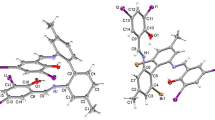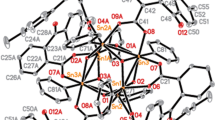Abstract
Two new ligands, 4-hydroxy coumarin-3-thiosemicarbazone (H2L1) and 4-hydroxy coumarin-3-semicarbazone (H2L2) were synthesized and used for the preparation of a series of transition metal complexes (Cr3+, Co2+, Ni2+, Cu2+, and Fe3+), derived from these ligands. These complexes have the forms [ML1Cl2]·nX (1–5) and [ML2Cl]·nX (6–9) (X = H2O or ethanol). The structures of these complexes were elucidated by elemental analyses, IR, UV–Vis, and electrical conductivity, as well as magnetic susceptibility measurements and thermal analyses. IR spectral data indicates that in all complexes, the ligands act as monobasic tridentate, coordinated through keto oxygen or sulfur, azomethine nitrogen and deprotonated phenolic oxygen atom. On the basis of other physicochemical investigations, tetrahedral or square planar geometries are assigned for Cu2+ complexes in monomeric structures. In the case of the Co2+, Ni2+ and Fe3+ complexes, octahedral stereochemistries in monomeric structures are suggested. The dissociation constants of the ligands and the stability constants of their Cu(II), Co(II), Ni(II), and Fe(III) complexes have been also determined using potentiometric pH-metric titration in mixed solvents of dioxane: H2O and DMF: H2O with different ratios and different temperatures.








Similar content being viewed by others
References
Mishra, D., Naskar, S., Drew, M.G.B., Chattopadhyay, S.: Synthesis, spectroscopic and redox properties of some ruthenium(II) thiosemicarbazone complexes: structural description of four of these complexes. Inorg. Chim. Acta 359, 585–592 (2006)
Casas, J.S., Garcia-Tasende, M.S., Sordo, J.: Corrigendum to main group metal complexes of semicarbazones and thiosemicarbazones. A structural review. Coord. Chem. Rev. 209, 197–261 (2000)
Padhye, S., Kauffman, G.F.: Transition metal complexes of semicarbazones and thiosemicarbazones. Coord. Chem. Rev. 63, 127–160 (1985)
Lobana, T.S., Rekha, R., Butcher, R.J., Castineiras, A., Bermejo, E., Bharatam, P.V.: Bonding trends of thiosemicarbazones in mononuclear and dinuclear copper(I) complexes: syntheses, structures, and theoretical aspects. Inorg. Chem. 45, 1535–1542 (2006)
West, D.X., Billeh, I.S., Jasinski, J.P., Jasinski, J.M., Butcher, R.J.: Complexes of N(4)-cyclohexylsemicarbazones and N(4)-cyclohexylthiosemicarbazones derived from 2-formyl-, 2-acetyl- and 2-benzoylpyridine. Trans. Metal Chem. 23, 209–214 (1998)
Kaminsky, W., Jasinski, J.P., Noudenberg, R., Goldberg, K.I., West, D.X.: Structural study of two N(4)-substituted thiosemicarbazones prepared from 1-phenyl-1,2-propanedione-2- oxime and their binuclear nickel(II) complexes. J. Mol. Struct. 608, 135–141 (2002)
Baldini, M., Ferrari, M.B., Bisceglie, F., Pelosi, G., Pinelli, S., Tarasconi, P.: Cu(II) complexes with heterocyclic substituted thiosemicarbazone: the case of 5-formyluracil. Synthesis, characterization, X-ray. Inorg. Chem. 42, 2049–2055 (2003)
Demertzi, D.K., Domopoulou, A., Demertzis, M.A., Valle, G., Papageorgion, A.: Palladium(II) complexes of 2-acetylpyridine N(4)-methyl, N(4)-ethyl and N(4)-phenyl-thiosemicarbazone. Crystal structure of chloro(2-acetylpyridine N(4)-methylthiosemicarbazonato) palladium(II). Synthesis, spectral studies, in vitro and in vivo antitumour activity. Inorg. Biochem. 68, 147–155 (1997)
Garciatojal, J., Pizarro, J.L., Garcia-Orad, A., Peraz-Sanz, A.R., Ugalde, M., Alvarez Diaz, A., Serra, J.L., Arriortua, M.L., Rojo, T.: Biological activity of complexes derived from thiophene-2-carbaldehyde thiosemicarbazone. Crystal structure of [Ni(C6H6N3S2)2]. Inorg. Biochem. 86, 627–633 (2001)
Patole, J., Padhye, S., Padhye, S., Newton, C.J., Anson, C.E., Powell, A.K.: Synthesis, characterization and in vitro anticancer activities of semicarbazone and thiosemicarbazone derivatives of salicylaldehyde and their copper complexes against human breast cancer cell line MCF-7. Ind. J. Chem. Sect. A 43, 1654–1658 (2004)
Padhye, S., Afrasiabi, Z., Sinn, E., Fok, J., Mehto, F., Rath, N., Deobagakar, D., Anson, C.E., Powell, A.K.: Antitumor metallothiosemicarbazonates: structure and antitumor activity of palladium complex of phenanthrenequinone thiosemicarbazone. Inorg. Chem. 44, 1154–1156 (2005)
West, D.X., Liberta, A.E., Padhye, S.B., Chikate, R.C., Sonawane, P.B., Kumbhar, A.S., Yerande, R.G.: Thiosemicarbazone complexes of copper(II): structural and biological studies. Coord. Chem. Rev. 123, 49–71 (1993)
Cowly, A.R., Dilworth, J.R., Donnely, P.S., Labisbal, E., Sousa, A.: An unusual dimeric structure of a Cu(I) bis(thiosemicarbazone) complex: implications for the mechanism of hypoxic selectivity of the Cu(II) derivatives. J. Am. Chem. Soc. 124, 5270–5271 (2002)
Iakovidou, Z., Papageorgiou, A., Demertzis, M.A., Mioglou, E., Mourelatos, D., Kotsis, A., Yadav, P.N., Kovala-Demertzi, D.: Platinum(II) and palladium(II) complexes with 2-acetyl-pyridine thiosemicarbazone: cytogenetic and antineoplastic effects. Anti Cancer Drugs 12, 65–70 (2001)
Marshalkin, V.N., Kurkovskaya, L.N., Smirnova, T.V.: The phenomenon of ring-chain tautomerism in derivatives of 2-phenyl-(4′-hydroxycoumarinyl-3′)-methylindane-1,3-dione. J. Struct. Chem. 24, 488–489 (1983)
Dempsey, E., O’Sullivan, C., Smyth, M.R., Egan, D., O’Kennedy, R., Wang, J.: Development on an antibody-based amperometric biosensor to study the reaction of 7-hydroxycoumarin with its specific antibody. Analyst 118, 411–413 (1993)
Traven-Valery, F., Negrebetsky-Vadim, V., Vorobjeva-Larisa, I.: Keto–enol tautomerism, NMR spectra, and H-D exchange of 4-hydroxycoumarins. Can. J. Chem. 75, 377–388 (1997)
Hirata, K., Shimoda, T., Fujino, T., Ohta, S.: Biotransformation of hydroxycoumarins by the cultured cells of Nicotiana tabacum. J. Mol. Catal. B 10, 477–481 (2000)
Abou-Melha, K.: Octahedral Co(II) and Ni(II) complexes of Schiff bases, semicarbazone and thiosemicarbazone, synthesis, biological, spectral, and thermal studies. J. Coord. Chem. 61, 2053–2067 (2008)
Agrawal, Y.K.: Correction factor for glass electrode for aqueous dioxane. Talanta 20, 1354–1356 (1973)
Gonzalez, A.G., Pablos, F.: Evaluation of acidity constants in dioxane–water mixtures by spectrophotometric and potentiometric pH titrations. Anal. Chim. Acta 251, 321–325 (1991)
Nakamoto, K.: Infrared and Raman spectra of inorganic and coordination compound, 2nd edn. pp. 222–223. Wiley-Interscience, New York (1970)
West, D.X., Pannell, L.K.: Transition metal ion complexes of thiosemicarbazones derived from 2-acetylpyridine N-oxide. II. The 4N-dimethyl derivative. Transit. Met. Chem. 14, 457–462 (1989)
West, D.X., Kozub, N.M., Bain, G.A.: Copper(II) complexes of 2-formyl-,2-acetyl- and 2-benzoylpyridine N(4)-o-, N(4)-m-, N(4)-p-chlorophenylthiosemicarbazones. Transit. Met. Chem. 21, 52–57 (1996)
Earnshaw, A.: Introduction to Magnetochemistry. Academic Press, London (1968)
Irving, H., Griffiths, J.M.M.: The stabilities of complexes formed by some bivalent transition metals with N-alkyl-substituted ethylenediamines. J. Chem. Soc. 213–223 (1954)
Irving, H., Williams, R.J.P.: The stability of transition metal complexes. J. Chem. Soc. 75, 3192–3210 (1953)
Millar, K.B., Tan, T., Aller, D.W.: Coordination Chemistry: Experimental Methods. Butterworths, London (1973)
Inczedy, J.: Analytical Applications of Complex Equilibria. Ellis Horwood Ltd., Wiley, New York (1976)
Fabbrizzi, L., Perotti, A., Poggi, A.: The deprotonated amido vs. the amino group in the stabilization of coordinated trivalent copper and nickel cations. An electrochemical evaluation. Inorg. Chem. 22, 1411–1412 (1983)
Kimura, E., Koike, T., Machida, R., Nagai, R., Kodama, M.: Effects of imide anions and axial donors on the stability and oxidation behavior of square-planar 13–15-membered macrocyclic tetraamine complexes of nickel(II) and copper(II). Inorg. Chem. 23, 4181–4188 (1984)
Fabbrizzi, L., Kaden, T.A., Perotti, A., Seghi, B., Siegfried, L.: Complexation of divalent and trivalent nickel and copper ions by rigid and flexible dioxo tetraaza macrocycles. Inorg. Chem. 25, 321–327 (1986)
Fabbrizzi, L., Licchelli, M., Pallavicini, P., Perotti, A., Sacchi, D.: An anthracene-based fluorescent sensor for transition metal ions. Angew. Chem. Ed. Engl. 33, 1975–1977 (1994)
Amendola, V., Brusoni, C., Fabbrizzi, L., Mangano, C., Miller, H., Pallavicini, P., Perotti, A., Taglietti, A.: Molecular rearrangements controlled by pH-driven Cu2+ motions. Chem. Soc. Dalton Trans. 3528–3533 (2001)
Amendola, V., Fabbrizzi, L., Mangana, C., Pallavicini, P.: Molecular machines based on metal ion translocation. Acc. Chem. Res. 34, 488–493 (2001)
Tweedy, B.G.: Possible mechanism for reduction of elemental sulfur by Monolina fructicola. Phytopathology 55, 910–914 (1964)
Author information
Authors and Affiliations
Corresponding author
Electronic supplementary material
Below is the link to the electronic supplementary material.
Rights and permissions
About this article
Cite this article
Mosa, A.I., Ibrahim, M.M. & Aldhlmani, S.A. Spectroscopic and Solution Studies of Some Transition Metal Complexes of New 4-Hydroxy Coumarin Semi- and Thiosemicarbazone Complexes. J Solution Chem 42, 2364–2383 (2013). https://doi.org/10.1007/s10953-013-0108-5
Received:
Accepted:
Published:
Issue Date:
DOI: https://doi.org/10.1007/s10953-013-0108-5




